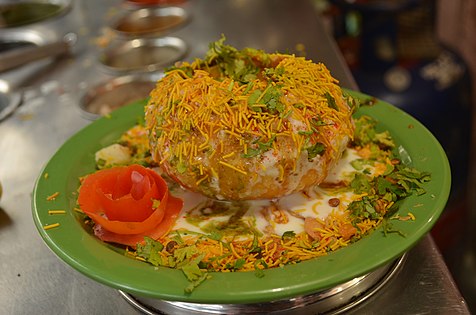Kachori
 Kachoris | |
| Course | Snack |
|---|---|
| Place of origin | India |
| Region or state | Rajasthan, India |
| Associated cuisine | India, Nepal, Bangladesh, Pakistan |
| Serving temperature | Hot or Warm |
| Main ingredients | Maida (flour), gram flour, ghee |
| Variations | Pyaaz Kachori Kota Kachori Raj Kachori Mawa Kachori |
Kachori (pronounced [kətʃɔːɽi]) is a sweet and spicy deep-fried snack, originating in India, and common in places with Indian diaspora and other South Asian diaspora. Alternative names for the snack include kachauri, kochuri, kachodi and katchuri.[1][2]
History[edit]
An early known recipe similar to kachori comes from Susruta Samhita which mentions deep-fried pastry made from flour, ghee and jaggery and stuffed with spiced mung dal or minced meat.[3] Another recipe for a dish known as "Kacchari", a puffy deep-fried pastry stuffed with lentils, finds mention in a Jain text dating back to the 7th century.[4] Similar recipes are also mentioned in the medieval cookbook Supa Shastra.[5] Kachori is believed to have originated in the Indian State of Rajasthan.[6] It is usually a round flattened ball made of fine flour filled with a stuffing of baked mixture of yellow moong dal or urad dal (Mung bean or Vigna mungo), besan (chickpea flour), black pepper, red chili powder, salt and other spices.
Banarasidas, the author of the biographical Ardhakathanaka, has mentioned buying Kachoris in Indore in 1613.[7] For seven months, he bought a ser of Kachoris daily, and owed twenty rupees.[8]
Variations[edit]
- Pyaaz Kachori: Pyaaz Kachori or Kanda Kachori originated in the city of Jodhpur, Rajasthan. As it's name suggest, it is stuffed with spiced pyaaz (onions).[9]

- Raj Kachori(s): Originating from the city of Bikaner in Rajasthan, Raj kachoris are now popular throughout North India.[10][11] Raj" in Hindi means "royal" or "grand" refering to the grandeur stuffing of the kachori. It's typically topped with plenty of yogurt, spices, cilantro chutney, sweet tamarind chutney, sev and pomegranate, making it a perfect combination of flavours.[12]

- Kota Kachori(s): Originating from the city of Kota in Rajasthan are renowned for their spicy flavour with a distinct smell of hing (ASAFOETIDA). The filling of Kota Kachori consists of yellow moong dal (split yellow lentils) cooked with a blend of spices and herbs, including cumin, ginger, green chili, turmeric, and coriander. [13][14]
Another form of Kachori in Jodhpur is the Mawa Kachori, invented by the late Rawat Deora. It is a sweet dish dipped in sugar syrup.
In Gujarat, it is usually a round ball made of flour and dough filled with a stuffing of yellow moong dal, black pepper, red chili powder, and ginger paste.
In West Bengal and Bangladesh, a kachori (often pronounced kochuri) has a quite different variation. In West Bengal, kachori is softer and smaller. It is made mostly of white flour (maida) and asafoetida (hing), which are often added to improve its taste. It is mostly eaten as a tea-time snack in the morning or evening often accompanied with potato-peas curry and Bengali sweets. Also, a kachori stuffed with peas (koraishuti kochuri) is a winter delicacy in Bengal. Another variant in Bengal that exists mostly in sweet shops is the hard form (like in Delhi) with a masala inside called 'Khasta Kochuri'. Generally, no curry is accompanied by the khasta kochuri version.
Some of the variants in North India include a version similar to the Rajasthani one, accompanied by a curry made of potatoes and varied spices or even chana (chole) similar to one served in chole bhature.
Gallery[edit]
-
Dal Kachoris
-
Bengali Kachoris in Kolkata
-
Raj Kachori, popular chaat food
-
Raj Kachori with spiced green gram lentils, chickpeas, served with yogurt, chutnies and sev on top.
-
Haldiram Raj Kachori
See also[edit]
References[edit]
- ^ liza (21 May 2023). "Perfecting Your Kachori Recipe – No Master Chef Required!". Desher Barta. Retrieved 21 May 2023.
- ^ Samosas from Sindh, kachoris from Old Delhi, R. V. SMITH, The Hindu, 30 January 2016
- ^ Feasts and Fasts: A History of Food in India, pg125, Colleen Taylor Sen · 2015
- ^ Feasts and Fasts: A History of Food in India, pg151, Colleen Taylor Sen · 2015
- ^ Feasts and Fasts: A History of Food in India, pg168, Colleen Taylor Sen · 2015
- ^ "RAJ KACHORI-THE ROYAL AMONG THE KACHORIS!". Indian hotspot.com.
The existence of kachoris can be dated back to 1613 in Rajasthan even before Samosas, another popular street delicacy.
- ^ Banarasidas, Ardha-Kathanaka, verses 335-342
- ^ Nathuram Premi, Kavivar Banarsidas viracit Ardha Kathanaka, Bombay, Hindi Granth Ratnakar, 1957
- ^ Limited, Foodity (P) (23 February 2024). Beyond Brick and Mortar: Unveiling the Soul of India's Street Food. Notion Press. ISBN 979-8-89277-770-4.
- ^ "How did Kachori Become The Most Loved Snack?". Slurrp. Retrieved 28 April 2024.
- ^ vijaydairysurat (31 July 2023). "Raj Kachori Chaat At Vijay Dairy". Retrieved 28 April 2024.
- ^ Singh, Manali (17 October 2020). "Raj Kachori". Cook With Manali. Retrieved 28 April 2024.
- ^ Sen, Colleen Taylor; Bhattacharyya, Sourish; Saberi, Helen (23 February 2023). The Bloomsbury Handbook of Indian Cuisine. Bloomsbury Publishing. ISBN 978-1-350-12865-1.
- ^ "Savor the Irresistible Delight: Kota Kachori - A Triumph of Flavors! - Pure N Desi". purendesi.in. 15 June 2023. Retrieved 28 April 2024.





